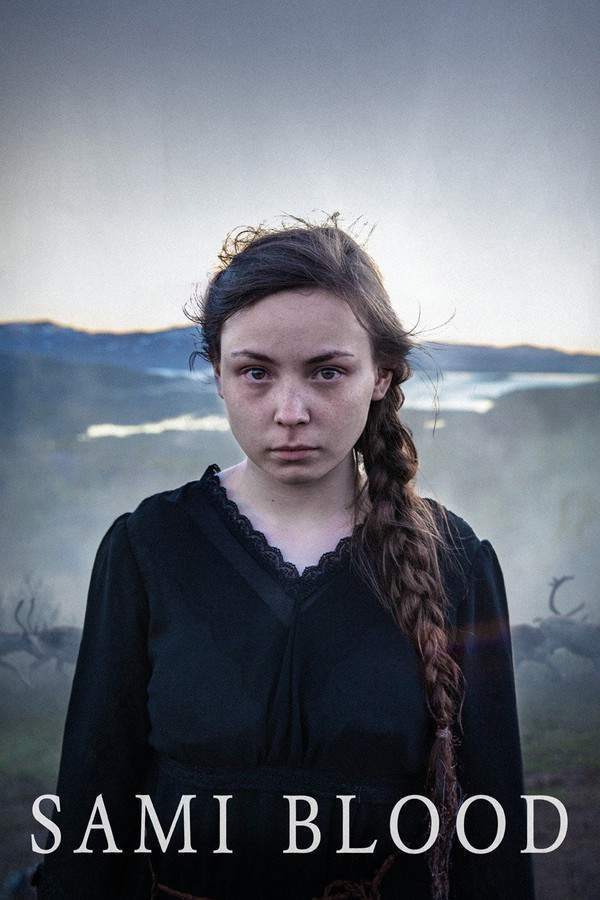Sami Blood 2017

A young Sámi woman rebels against her traditional life and is forced to attend a state-run boarding school designed to assimilate indigenous children. There, she endures cultural erasure and strict societal conditioning, struggling to maintain her identity while facing the painful legacy of colonialism. The film explores themes of belonging, cultural survival, and the fight for Sámi rights.
Does Sami Blood have end credit scenes?
No!
Sami Blood does not have end credit scenes. You can leave when the credits roll.
Meet the Full Cast and Actors of Sami Blood
Explore the complete cast of Sami Blood, including both lead and supporting actors. Learn who plays each character, discover their past roles and achievements, and find out what makes this ensemble cast stand out in the world of film and television.
External Links and Streaming Options
Discover where to watch Sami Blood online, including streaming platforms, rental options, and official sources. Compare reviews, ratings, and in-depth movie information across sites like IMDb, TMDb, Wikipedia or Rotten Tomatoes.
Ratings and Reviews for Sami Blood
See how Sami Blood is rated across major platforms like IMDb, Metacritic, and TMDb. Compare audience scores and critic reviews to understand where Sami Blood stands among top-rated movies in its genre.

The Movie Echo Score
Overall, Sami Blood excels in delivering a sensitive portrait of cultural identity and personal struggle, anchored by assured direction and an outstanding lead performance. The film’s strengths include elegant cinematography that immerses viewers in the Nordic landscape and a deeply felt emotional core generated by a nuanced central performance. Though the narrative occasionally lags in pacing and features familiar story beats, its strong sense of place and thematic resonance carry it through. In sum, the film offers a compelling and thoughtfully crafted drama that rewards attentive viewing.
The Movie Echo Score Breakdown for Sami Blood

Art & Craft
In terms of art and craft, the film displays assured direction and striking visual composition that evoke the Nordic setting with understated beauty. Reviewers highlight elegant tracking shots that glide through forests and well-executed editing that reinforces the measured pace. While some note a classic sheen, the film avoids feeling static by grounding its images in emotional context. Overall, the aesthetic execution is consistently compelling.

Character & Emotion
When it comes to character and emotion, Sami Blood is anchored by a powerful central performance that conveys complex internal conflict with nuance. The lead’s expressive facial work and naturalistic delivery create deep emotional connections, while supporting players reinforce the protagonist’s isolation and resilience. Though the film maintains a reserved tone throughout, its empathy-driven portrayal of identity is consistently convincing.

Story & Flow
In terms of story and flow, the narrative offers a quietly profound exploration of identity framed by measured pacing and hyper-specific detail. While its structure occasionally feels familiar and certain sequences slow the momentum, the film sustains engagement through thematic depth and coherent plot progression. Some viewers note a lack of narrative propulsion after pivotal moments, but the overall arc remains thoughtfully constructed.

Sensory Experience
From a sensory standpoint, Sami Blood employs a restrained yet evocative visual style that underscores its thematic concerns. The cinematography’s muted palette and soft natural light evoke the Nordic wilderness, while subtle sound design and an unobtrusive score reinforce the film’s haunting atmosphere. Although the auditory elements remain understated, they work in concert with the imagery to maintain immersive cohesion.

Rewatch Factor
Regarding rewatch factor, the film’s intense subject matter and deliberate pacing may limit its appeal for repeated viewings. The emotional weight and reflective tone create a compelling initial impact but can feel taxing on subsequent watches. However, viewers drawn to nuanced performances and thoughtful cultural context may find new layers in later viewings, offering moderate lasting appeal.

79
Metascore
6.8
User Score


97%
TOMATOMETER

85%
User Score

7.3 /10
IMDb Rating

74
%
User Score

3.7
From 24 fan ratings
Take the Ultimate Sami Blood Movie Quiz
Challenge your knowledge of Sami Blood with this fun and interactive movie quiz. Test yourself on key plot points, iconic characters, hidden details, and memorable moments to see how well you really know the film.
Sami Blood Quiz: Test your knowledge on the poignant film 'Sami Blood' and its exploration of cultural identity and resilience.
What is the original Sami name of the main character, Christina?
Marie
Elle-Marja
Njenna
Sanna
Show hint
Full Plot Summary and Ending Explained for Sami Blood
Read the complete plot summary of Sami Blood, including all major events, twists, and the full ending explained in detail. Explore key characters, themes, hidden meanings, and everything you need to understand the story from beginning to end.
In 2017, Christina, a 78-year-old woman, travels to a quaint town in Swedish Lapland accompanied by her son Olle Sarri and granddaughter Sanna, to partake in the Sami funeral of her younger sister. However, Christina, referred to by her original Sami name Elle-Marja, feels a strong aversion to being there. She harshly criticizes the Sami community, labeling them as “thieves and liars,” and her discomfort increases when spoken to in her native tongue, Southern Sami. Opting to avoid the family home of her late sister, she chooses to stay in a hotel instead. As the evening unfolds, Christina reflects on her past, particularly the childhood experiences that distanced her from her heritage.
Flashback to the 1930s
As a 14-year-old, Elle-Marja faces significant challenges; her mother is ill, prompting her to attend a nomadic boarding school for Sami children alongside her younger sister Njenna. Here, a blonde teacher named Christina Lajler enforces Swedish and a rigid hierarchy among the students. The punishment for speaking Sami, even in private conversations, is severe. Demonstrating exceptional academic prowess, Elle-Marja achieves perfect scores and exhibits a keen interest in literature, spurred on by her teacher’s encouragement. Presented with a poetry book by Edith Södergran, she finds herself increasingly alienated from her classmates. This sense of isolation escalates when researchers from the State Institute for Racial Biology arrive, measuring the children’s heads and taking invasive photographs, disregarding their feelings of shame.
After defending herself against a group of boys who mock her with derogatory names and slurs, Elle-Marja’s frustration boils over. Nicking the edge of her ear, reminiscent of Sami traditions, she discards her gaeptie and borrows a dress from her teacher’s line.
The Dance and Escape
Catching a glimpse of soldiers heading to a dance, Elle-Marja can’t resist the urge to follow. For a fleeting moment, she experiences respect and dignity, dancing with a boy named Niklas, who is from Uppsala. Under the guise of a different identity, Christina, she chooses not to disclose her Sami heritage. Nevertheless, her sister, informed about Elle-Marja sneaking away, disrupts this moment of freedom, resulting in Elle-Marja facing punishment.
Determined to pursue her education, Elle-Marja seeks a recommendation from Christina Lajler, who begrudgingly acknowledges her intellect but firmly states that Sami people are not suited for advanced studies. In a moment of rebellion, Elle-Marja resolves to escape to Uppsala; she steals clothes, discards her gaeptie, and enters Niklas’ home uninvited. Though they share an intimate moment, Niklas’ family soon realizes her background and asks her to leave, forcing her to seek shelter outdoors.
New Beginnings and Harsh Realities
In Uppsala, she adopts the name Christina Lajler and enrolls in school. Just as she begins to forge new friendships, financial burdens surface when she receives a bill for tuition. In a bid to cover her costs, Elle-Marja returns to Niklas’ celebration, hoping for assistance. However, she faces humiliation as a group discovers her ancestry and coerces her into performing a traditional joik during the party.
Unable to sustain her schooling, Elle-Marja reluctantly heads back home, where resentment brews against her Sami origins. She wishes to sell her share of the family reindeer to raise funds but is met with rejection from her mother, who is rooted in preserving their culture. In a tender but silent act of love, the next morning, her mother presents her with a silver belt, a legacy from her father, enabling Elle-Marja to continue her education.
As the narrative returns to 2017, Christina finds a moment of reconciliation, expressing her long-overdue sorrow to her deceased sister Njenna, speaking in South Sami.
Uncover the Details: Timeline, Characters, Themes, and Beyond!

Coming soon on iOS and Android
The Plot Explained Mobile App
From blockbusters to hidden gems — dive into movie stories anytime, anywhere. Save your favorites, discover plots faster, and never miss a twist again.
Sign up to be the first to know when we launch. Your email stays private — always.
Watch Trailers, Clips & Behind-the-Scenes for Sami Blood
Watch official trailers, exclusive clips, cast interviews, and behind-the-scenes footage from Sami Blood. Dive deeper into the making of the film, its standout moments, and key production insights.
Cars Featured in Sami Blood
Explore all cars featured in Sami Blood, including their makes, models, scenes they appear in, and their significance to the plot. A must-read for car enthusiasts and movie buffs alike.
Sami Blood Themes and Keywords
Discover the central themes, ideas, and keywords that define the movie’s story, tone, and message. Analyze the film’s deeper meanings, genre influences, and recurring concepts.
Sami Blood Other Names and Titles
Explore the various alternative titles, translations, and other names used for Sami Blood across different regions and languages. Understand how the film is marketed and recognized worldwide.
Similar Movies To Sami Blood You Should Know About
Browse a curated list of movies similar in genre, tone, characters, or story structure. Discover new titles like the one you're watching, perfect for fans of related plots, vibes, or cinematic styles.
Quick Links: Summary, Cast, Ratings, More

What's After the Movie?
Not sure whether to stay after the credits? Find out!
Explore Our Movie Platform
New Movie Releases (2025)
Famous Movie Actors
Top Film Production Studios
Movie Plot Summaries & Endings
Major Movie Awards & Winners
Best Concert Films & Music Documentaries
Movie Collections and Curated Lists
© 2025 What's After the Movie. All rights reserved.








































